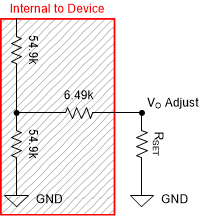Other Parts Discussed in Thread: PTN78020W
Dear whom it may concern,
I am currently analyzing PTN78020WAH to bring 12 V to 5 V. Which I was able to achieve.
However, my Rset value is 13.1 kOhm and it gives 5 V output voltage. By the specification sheet, it is suppose to bring 6 V which is not accepted in our system.
Even though I have a successful output, I just don't understand why.
FYI, I use two parallel 2.2 uF Ceramic in the input voltage, and one 330 uF capacitor on the output. This wouldn't affect that....
Could you please explain how and why this could happen?
Thank you.


